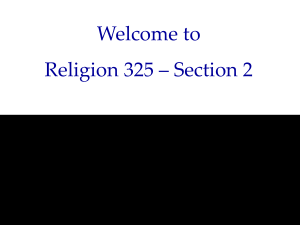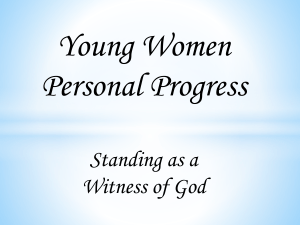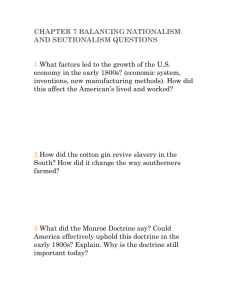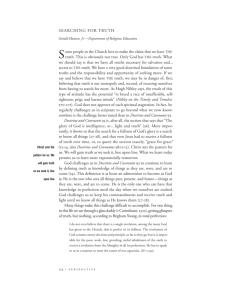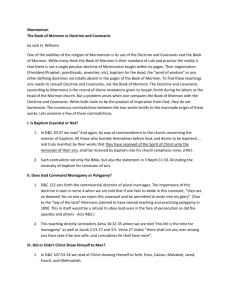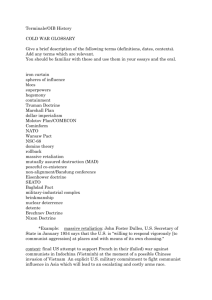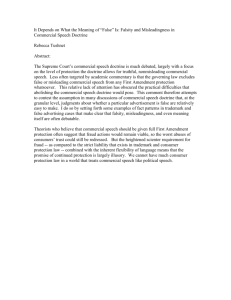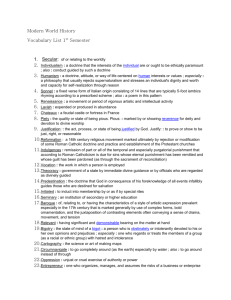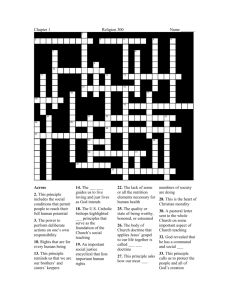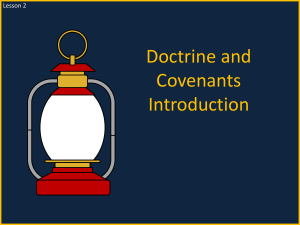Lesson Notes here - Mormon Sunday School
advertisement
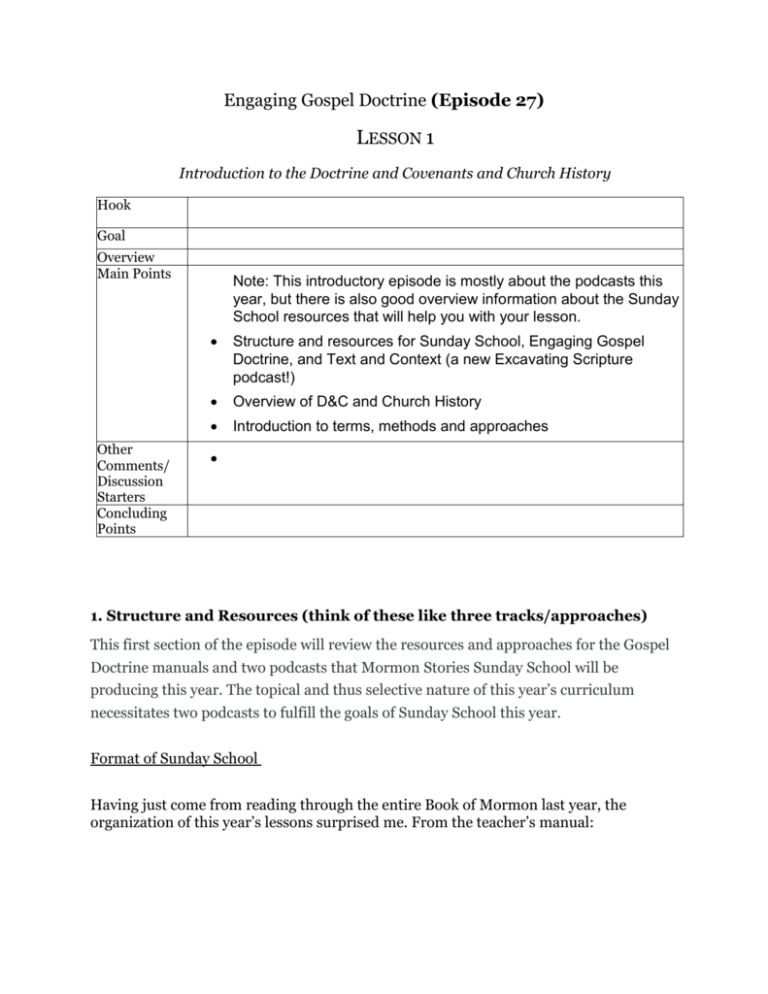
Engaging Gospel Doctrine (Episode 27) LESSON 1 Introduction to the Doctrine and Covenants and Church History Hook Goal Overview Main Points Other Comments/ Discussion Starters Concluding Points Note: This introductory episode is mostly about the podcasts this year, but there is also good overview information about the Sunday School resources that will help you with your lesson. Structure and resources for Sunday School, Engaging Gospel Doctrine, and Text and Context (a new Excavating Scripture podcast!) Overview of D&C and Church History Introduction to terms, methods and approaches 1. Structure and Resources (think of these like three tracks/approaches) This first section of the episode will review the resources and approaches for the Gospel Doctrine manuals and two podcasts that Mormon Stories Sunday School will be producing this year. The topical and thus selective nature of this year’s curriculum necessitates two podcasts to fulfill the goals of Sunday School this year. Format of Sunday School Having just come from reading through the entire Book of Mormon last year, the organization of this year’s lessons surprised me. From the teacher’s manual: “because this year’s lessons are thematic, some sections of the Doctrine and Covenants are not included in the reading assignments. Nevertheless, class members should plan to read the entire Doctrine and Covenants during the year.” One of my friends crunched the numbers, and “some sections not included” amounts to 51 sections of the D&C! Only 11 are assigned in their entirety (13 if you include OD2 and Family Proclamation; 2, 4, 13, 20, 25, 65, 76, 89, 119, 136, 138 if you are interested). A full 25% of all verses assigned come from two sections of the D&C (76 and 20). Half of the readings come from nine sections. Resources: Student Manual: The primary readings in the student manual consist of “scripture chains” of about 10-20 passages that illustrate the theme of the lesson. Topical study has its advantages, but this approach makes it even harder to complete the assigned reading! Knowing you need to cover four chapters of the Book of Mormon is one thing, but to do the reading this year you need to have the manual right in front of you. Teacher’s Manual: Though the teacher’s manual is also topical, teachers are assigned to read well over half of the D&C sections (70, both declarations, and the intro) (intro,1,2,3,4,5,6,8,9,10,11,12,13,14,15,16,17,18,20,21,22,25,26,27,28,31,33,37,42,46,50,5 1,52,59,65,75,76,78,81,82,84,86,87,89,90,95,101,102,103,104,105,107,109,110,112,118,11 9,120,121,122,124,126,127,128,131,133,134,135,136,137,138,OD1,OD2,family proc) Our Heritage: “"Our Heritage draws from the history of the expanding Church and its global membership in the last 50 years. Another key benefit is that this book contains the testimonies of the latter-day presidents of the Church about the Savior and the Redeemer of the world, Jesus Christ, and ties those testimonies to the principles that have helped us to become God's latter-day covenant people."” http://www.ldschurchnews.com/articles/27282/Study-aid-will-teach-Church-heritage---book-emphasizes-spiritual-legacy-of-all-members.html Introduction (first chapters self-explanatory) Chapter One: The First Vision 1 Chapter Two: Establishing the Foundations of the Church 5 Chapter Three: Building the Kingdom in Kirtland, Ohio 21 Chapter Four: Establishing Zion in Missouri 37 Chapter Five: Sacrifice and Blessings in Nauvoo 55 Chapter Six: Faith in Every Footstep (Pioneers traveling from Nauvoo to Utah, Handcarts, Mormon battalion) Chapter Seven: Establishing an Ensign to the Nations (early history in Utah) 2 Chapter Eight: A Period of Trials and Testing (Persecution because of polygamy, the manifesto under Woodruff, Lorenzo Snow and tithing) Chapter Nine: The Expanding Church (Joseph F. Smith, Heber J. Grant, George Albert Smith, David O. McKay) Chapter Ten: The Worldwide Church (Joseph Fielding Smith, Harold B. Lee, Spencer W. Kimball) Chapter Eleven: The Present-day Church 133 Conclusion 145 (20% of the pages are assigned in the student manual) Format of Engaging Gospel Doctrine EGD will continue to follow the manual and reading schedule (working to get about a week ahead of everyone) and seeks to model a “best version” of Sunday School teaching that connects the scriptures and gospel to real life experiences and issues as well as providing supplementary resources for a substantive and rewarding Sunday School experience. Resources: There are a few key resources that will help you as you study the D&C and Church History this year. We have listed these on the “Resources page” at www.MormonSundaySchool.org On the Doctrine & Covenants Steven Harper, Making Sense of the Doctrine & Covenants: A Guided Tour through Modern Revelations. Available at Deseret Book or on Kindle. Lyndon Cook, The Revelations of the Prophet Joseph Smith: A Historical and Biographical Commentary of the Doctrine and Covenants. Available for under $8 on Kindle. On Church History Richard Bushman, Mormonism: A Very Short Introduction. Matthew Bowman, The Mormon People: The Making of an American Faith Leonard Arrington, The Mormon Experience: A History of the Latter-day Saints In addition, the following site and article provide a great starting point: The sections of the D&C sorted by chronology and location on lds.org An Ensign article on the history of the D&C by Robert J. Woodford, the editor of the Joseph Smith papers. Overview of Church History at pbs.org Format of Text & Context (This year’s Excavating Scripture Supplement) As discussed in the first episode of Mormon Sunday School, in addition to teaching the weekly Sunday School lessons there will be other content that will make up a virtual “ward library” so to speak. When I realized that the student and teacher’s manuals did not cover the Doctrine and Covenants reading, I decided the best solution would be to produce an additional podcast that discusses the Doctrine & Covenants in modified sequential order (rearranged somewhat by chronology and topic) as well as providing historical context. I hope that all of you will take advantage of this resource. I will add the first episode to the EGD feed, and then it will have its own iTunes subscription. We are still looking for people to help research, produce, and even teach this podcast, so let us know if you feel qualified and are interested! Text & Context will cover approximately 10-15 sections per month (averaging about 80 verses per week/podcast) . We will mostly cover the period of the revelations to Joseph Smith, so 1823-1844, but will have a few concluding episodes that discuss the five revelations outside that period as well as Church History to the present. Resources: Doctrine & Covenants Best, Karl F. “Changes in the Revelations, 1833 to 1835,” Dialogue Vol. 25, Issue 1. Black, Susan Easton. Who’s Who in the Doctrine & Covenants. Salt Lake City: Bookcraft 1997. Howard, Richard P. Restoration Scriptures: A Study of Their Textual Development. Reorganized Church of Jesus Christ of Latter Day Saints Dept. of Religious Education: Herald Publishing House 1969. Marquardt, H. Michael. The Joseph Smith Revelations: Text and Commentary. Salt Lake City: Signature Books 1999. Van Wagoner, Richard S. et al. “The ‘Lectures on Faith’: A Case Study in Decanonization,” DialogueVol. 20, Issue 3. Church History 4 Flanders, Robert B. Nauvoo: Kingdom on the Mississippi. Urbana, Illinois: University of Illinois Press 1965. Leonard, Glen M. Nauvoo: A Place of Peace, A People of Promise. Salt Lake City: Deseret Book 2002. Staker, Mark Lyman. Hearken, O Ye People: The Historical Setting of Joseph Smith’s Ohio Revelations. Draper, Utah: Greg Kofford Books 2010. WOMAN’S EXPONENT DESERET NEWS [weekly edition, 1850-1898) General Resources for Scripture Study Websites TIMES AND SEASONS JOURNAL OF MORMON HISTORY BYU STUDIES DIALOGUE We will introduce more resources as they come to our attention, and feel free to make suggestions! 2. Overview A. D&C. Two overviews: First, the Institute manual table of contents: http://www.ldsces.org/inst_manuals/dc-ssg/manualindex.asp Second, a Handy little bookmark: http://www.meckmom.com/dl/Bookmark_D&C_Section_Summ.pdf As the Explanatory Introduction notes, the content of the Doctrine & Covenants falls into several types of categories. These include: Theological treatises (with a strong emphasis on the end of the world, but overall sublime content), directions to specific individuals including mission calls and chastisement; Church organization including the revealing of priesthood keys and ordinances; and responses to particular questions and situations, many of these relating to biblical material. Be looking for these as you read! B. Church History. PBS has a good overview of important events in Church History: http://www.pbs.org/mormons/timeline/index.html C. History of the Doctrine and Covenants 3. Discussion of approaches and methods Some helpful concepts and vocabulary: Terms: Past: The time period before now, and what happened then. It is mostly irretrievable, even in our own lives! History: History does not equal the past. It is a *story* told or written about the past. It is a reconstruction. In a strict sense, there is nothing but historical fiction. There can be no history without interpretation, and we all have our own biases and cultural contexts that influence how we understand the past. Accurate: Free from error “Historically accurate” is more precise than “true” (Precise just means specific, not accurate) Fact: Descriptions of how things are, the state of things. There are less of them than you probably think. Critical: Critical does not mean negative. Critical means careful, reasoned, and effortful analysis. When we engage in critical thinking we put aside what we think we know and seek to understand what we should believe and do based on all available evidence and best ways we know to approach a given issue. Theology: Theology seeks to understand spiritual reality and the ways of God. God’s character, the meaning of life, and questions of meaning are all theological questions. Theology is a creative exercise that constructs or extrapolates a consistent, satisfying explanation of reality and life from a spiritual perspective. Myth: Myth does not necessarily imply “not true”. Myths are stories that reflect spiritual and internal realities and often grant meaning to our lives. They are narratives that help us understand life and reality. Usually they are legends that do not have a historical basis, but the word means more than that. Inspired: Influenced by a higher, usually divine source Revelation: a message that comes from God True: Corresponds to reality, but this is more complicated than “historically accurate”, because there are multiple levels of reality. Usually theories of truth are broken up into Correspondence (A statement is true if it corresponds to reality as we understand it), Pragmatic (something is true if it works or is beneficial), and Coherence (something is true if it corresponds to other known truths). One of my favorite examples to evaluate truth is a composite narrative put together by a therapist to illustrate a key principle of relationships. The story is not exactly true, though it is made up of true stories, and the 6 principle it teaches is true in a way more important than the fact that specific narrative never happened. Putting these together: Facts are descriptions of what is. For example, we have certain manuscripts with certain words, or a given statue was found in a particular location, or a coin was found in a particular layer of soil. Think of it like a detective story (CSI: The Scriptures). There is a dead body on the ground. But these facts don’t tell us whether a work is authentic or a forgery, what date a text was written, or whether a death comes of natural or suspicious causes. We combine facts (which we count as evidence) to build arguments and come to conclusions. This is our interpretation. Approaches: What a literary critic does: A literary critic seeks to understand what the text means (or what meaning can be drawn from the text which is slightly different) by noticing details such as genre, emphasis, repetition, imagery, characterization, etc. To use a food analogy, the literary critic would notice how the food is presented and the impact that presentation has on the one eating the food. They would note whether the dish is an appetizer, main course, or dessert, how the flavors go together, what cultural influences are present, and so forth. What a historian does: A historian uses textual (and material evidence when available) evidence and critical methodology to determine insofar as possible what happened in the past. For example, one historical tool is called the “criterion of dissimilarity”, which means if a story goes against the interests or agendas of the one telling it, it is more likely to be true. In our food analogy the historian would deconstruct the meal to determine its ingredients. What a theologian does: A theologian seeks to understand what the text teaches about God, life, and spiritual realities, usually taking all evidence to put together a coherent system of belief. In our food analogy, the theologian is concerned with how the food tastes and nourishes. Summary: How we can approach a text (literary, historical, theological, ethical, critical, but the elements are all mixed together) Talk about what each text and podcast is doing with this context. All this foundation laid, let’s get into the readings for this week: Introduction to the D&C Doctrine & Covenants 1 8
